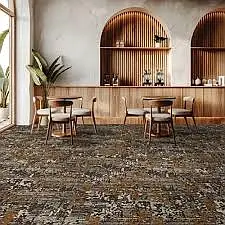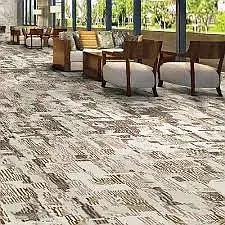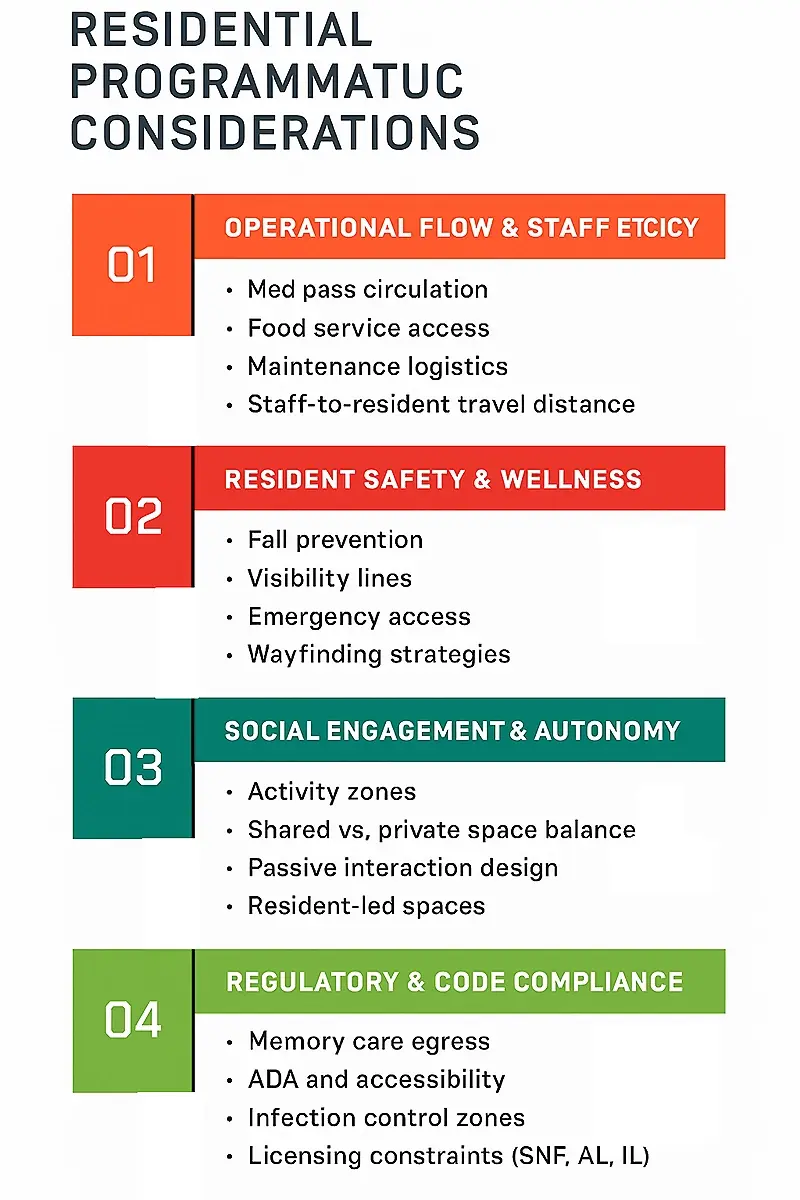Commercial Carpet in Senior Living: Technical Considerations
- Senior Living+Studio

- Jul 2
- 11 min read
Updated: Jul 7
Commercial carpet selection and installation in senior living communities presents unique technical challenges that extend far beyond traditional hospitality or office environments. While carpet offers undeniable benefits including acoustic control, fall protection, and residential aesthetic appeal, the physiological changes associated with aging create specific vulnerabilities that inappropriate carpet design can dangerously exacerbate. Recent research demonstrates that seniors with macular degeneration—affecting over 20 million U.S. adults—experience significantly reduced contrast sensitivity that makes carpet pattern recognition particularly challenging, (Aoa) with over 31% of intermediate AMD patients failing normal contrast sensitivity thresholds.(Wiley)

The technical complexity deepens when considering that carpet decisions are typically made in controlled showroom environments under standardized 3000K–4000K lighting that bears little resemblance to actual installation conditions. Meanwhile, installation practices suffer from systemic accountability gaps through subcontracting networks, leading to compromised seam integrity and adhesive failures that create safety hazards in environments where fall risk already claims over $50 billion annually in medical expenses. This analysis examines commercial carpet in senior living and these interconnected technical challenges across independent living (IL), assisted living (AL), and memory support unit (MSU) environments, providing evidence-based guidance for design and construction professionals navigating this complex specification landscape.
Regulatory compliance framework across senior living environments
The regulatory landscape for commercial carpet in senior living facilities operates under multiple overlapping jurisdictions that create complex compliance requirements varying significantly across IL, AL, and MSU classifications. ADA accessibility standards establish fundamental performance criteria, requiring carpet pile height not exceed ½ inch with firm, stable installation preventing shifting or movement. The critical distinction lies in occupancy classifications: IL facilities typically fall under IBC Group R-2 residential requirements, while AL facilities must comply with IBC Group I-1 occupancy standards requiring enhanced fire protection systems per NFPA 101: Life Safety Code, Chapter 32.
ASTM performance standards become particularly stringent for healthcare-adjacent environments. ASTM E648 critical radiant flux testing requires Class I rating (≥ 0.45 W/cm²) for corridors and exitways in AL and MSU facilities, while ASTM D2859 flammability testing mandates all carpet pass the methenamine tablet test. The updated ASTM E303‑22 slip resistance standard replaces withdrawn standards, requiring a minimum Pendulum Test Value (PTV) of 36 for level floors. See also ANSI A117.1 for comprehensive accessibility details.
Memory support units face the most restrictive requirements due to secured occupancy characteristics and specialized egress systems. CRI Green Label Plus certification becomes essential for these environments, requiring ultra-low VOC emissions (≤0.5 mg/m²-hr total VOCs) that meet California Section 01350 standards. State licensing variations compound complexity, with some jurisdictions mandating enhanced cleaning protocols and specialized antimicrobial treatments beyond federal minimums. For broader senior fall-prevention policy guidance, refer to the CDC STEADI Program and AARP Fall Prevention Resources.
Commercial carpet in senior living and the visual impairments interaction challenges
Age-related macular degeneration fundamentally alters how seniors perceive and navigate carpeted environments, creating safety hazards that extend far beyond simple slip resistance metrics. Research demonstrates that AMD patients rely increasingly on peripheral vision while losing central detail recognition, making carpet pattern interpretation particularly problematic. Clinical studies reveal that repetitive carpet patterns cause measurable neurological symptoms including headaches, dizziness, vertigo, and nausea—physiological responses that can trigger fall incidents in already vulnerable populations.
The physiological mechanism involves compromised contrast sensitivity function that deteriorates more rapidly than visual acuity in AMD progression. Experimental studies using yellow lens shields to simulate 80-year-old vision found that 14 of 20 participants rated patterned carpets as "overpowering," while high-contrast geometric patterns created perceptual confusion where carpets were misinterpreted as three-dimensional obstacles. Field studies at continuing care retirement communities documented significant gait modifications on patterned surfaces, with seniors demonstrating reduced stride length and velocity under various lighting conditions.
The cascading safety implications prove substantial: research indicates patterned carpets contribute to over 25% of annual senior falls, with hospital-based controlled trials showing significantly higher incident rates in carpeted versus vinyl flooring environments. Color discrimination challenges compound these risks as age-related lens yellowing shifts color perception, particularly affecting blue spectrum discrimination critical for pattern differentiation. These physiological changes necessitate fundamental reconsideration of traditional carpet selection criteria prioritizing aesthetic appeal over evidence-based safety considerations.

Memory support units present additional complexity as cognitive impairments interact with visual processing challenges. NIH research emphasizes that environmental design significantly impacts aging biology, with visual environment modifications identified as crucial interventions for maintaining independence and reducing fall risk in dementia populations. Additional aging and vision resources can be found via the American Optometric Association and NIA’s Vision Loss and Aging portal.
Lighting effects and color temperature considerations
The interaction between lighting design and carpet performance represents one of the most underestimated technical challenges in senior living construction. IES ANSI/RP-28-20 standards specifically recommend 3000K color temperature for senior facilities instead of traditional 2700K residential lighting to compensate for age-related color discrimination loss, yet carpet selections are routinely made under showroom conditions using standardized lighting that fails to reflect actual installation environments.
Color temperature variations between 2700K and 4000K create dramatic appearance changes in carpet installations. At 2700K, warm yellowish hues mask cool undertones and reduce perceived contrast critical for pattern recognition, while 4000K lighting enhances true color representation but may appear clinically inappropriate for residential-style environments. The IES-recommended 3000K provides optimal balance, improving visual acuity while maintaining residential comfort, but requires high CRI (≥80, preferably ≥90) to ensure accurate color rendering.
Metamerism effects compound these challenges when carpets appear to match in controlled environments but demonstrate significant color variations under site lighting conditions. Real-world installations face mixed lighting sources creating color temperature variations, interaction with wall colors and reflective surfaces, and natural daylight integration effects that showroom evaluations cannot predict. Research indicates that seniors lose up to 5 lines of visual acuity from glare sources that minimally affect younger populations, making uniform light distribution across carpet surfaces critical for safe navigation.
ASHRAE guidelines emphasize integrated design approaches that consider heat load and environmental effects from lighting systems, but coordination between lighting designers and flooring specifiers rarely occurs during early design development phases.
Wayfinding integration and transition challenges
The disconnect between carpet selection and wayfinding system development creates systematic navigation hazards in senior living environments where residents increasingly rely on visual cues for spatial orientation. Traditional approaches developing flooring and signage systems in isolation result in transition mismatches and conflicting visual information that compromise wayfinding effectiveness and increase fall risk at critical decision points.
Research demonstrates that carpet transitions represent major fall hazards, with metal transition strips contributing significantly to injury incidents and height differences between flooring types creating tripping hazards. Evidence-based wayfinding strategies emphasize path-based visual cues rather than pattern complexity, with LED strip lighting along carpeted corridors proving more effective than complex carpet patterns for directional guidance. Studies in nursing homes and assisted living facilities show residents rely heavily on environmental cues for navigation, making coordination between flooring transitions and directional signage essential for effective wayfinding systems.
The physiological basis for these challenges involves age-related changes in spatial processing and visual-vestibular integration. Seniors demonstrate reduced cortical inhibition and broader neural tuning curves that make environmental navigation increasingly dependent on clear, consistent visual information. Complex carpet patterns interfere with this processing, while poorly planned transitions create decision points that exceed cognitive processing capabilities in memory care populations.
Designers should reference best practices from the American Society of Interior Designers (ASID) Aging-in-Place design criteria and the Whole Building Design Guide (WBDG) Senior Living Facilities guide maintained by the National Institute of Building Sciences. Installation challenges and industry accountability gaps
Commercial carpet installation in senior living construction suffers from systematic quality control failures stemming from overreliance on subcontracting networks and inadequate accountability frameworks. The prevalent “finger-pointing” scenario occurs when retailers use subcontracted installers, leaving facility owners “stuck in the middle” when installation problems arise, with stores blaming installers and vice versa while warranty coverage remains uncertain.
Double subcontracting practices—where large retailers hire companies that subsequently hire installers—create additional responsibility dilution layers that compromise quality control in environments where installation precision directly impacts resident safety. Common installation failures include seam integrity problems from improper seaming iron temperatures, inadequate edge sealing leading to delamination, and adhesive failures from incorrect application or premature trafficking. These technical failures create ongoing maintenance burdens and safety hazards that facility operators struggle to address through fragmented warranty structures.
Pre-installation seam diagrams represent critical planning tools consistently underutilized in senior living projects. CRI 104/105 standards require installation plans with accurate measurements and seam placement specifications, yet practice reveals inadequate attention to traffic patterns, wheelchair pathways, and emergency egress routes specific to senior living operations. Seam placement in high-traffic corridors or transition thresholds leads to premature failure and costly replacement cycles that occupied building phasing requirements make particularly disruptive.
Installation in occupied buildings presents unique challenges requiring specialized expertise and enhanced project management protocols. 24/7 occupancy necessitates careful scheduling coordination, noise restrictions for resident health considerations, and dust/odor control critical for respiratory health in aging populations. Limited elevator access for material transport, restricted storage space, and emergency access route maintenance requirements increase installation complexity while subcontracted labor networks often lack senior living facility experience.
Post-installation accountability remains problematic with multiple warranty types covering different aspects of carpet performance—manufacturer product warranties for wear and stain resistance, installation warranties from contractors, and retailer satisfaction guarantees with varying coverage periods and exclusion conditions. Installation-related defects typically void manufacturer warranties while installation contractors may not warranty carpet performance, creating coverage gaps that leave facility owners responsible for expensive remediation.
Technical fiber performance characteristics

Solution-dyed nylon represents the performance benchmark for senior living applications, offering superior durability and appearance retention under the demanding conditions typical of healthcare environments. Technical specifications require minimum 5,000 yarn density for extra heavy traffic per CRI standards, with solution-dyed continuous filament nylon 6 and 6,6 providing optimal abrasion resistance and crush recovery characteristics. The manufacturing process integrates color into the polymer before fiber extrusion, ensuring fade resistance and eliminating color bleeding during cleaning procedures—critical for biofluids management.
Performance data demonstrates a 12–15 year expected lifespan in high-traffic commercial applications, with superior cleanability when combined with stain resistance treatments. The fiber’s compatibility with antimicrobial treatments proves essential for infection control protocols, while excellent resilience allows recovery from compression loading typical of wheelchair and walker traffic patterns.
Polyester alternatives offer specific advantages in moderate-traffic applications, with naturally hydrophobic PET and PTT fibers providing inherent stain resistance superior to nylon. The 65% solution-dyed market penetration for polyester reflects improved colorfastness performance, though reduced crush resistance limits applications to areas with lower traffic intensity. Expected lifespan of 8–10 years in commercial applications makes polyester cost-effective for specific senior living areas, while oil-based soil attraction requires specialized maintenance protocols.
Wool blend compositions, particularly 80/20 wool/nylon combinations, deliver unique performance benefits including natural flame resistance achieving Class II fire ratings without chemical treatments, superior acoustic properties providing sound absorption five times greater than hard surfaces, and natural static resistance through 30% moisture retention. The natural elasticity allowing 40% stretch and recovery provides fall safety benefits through natural cushioning, while inherent soil resistance reduces maintenance requirements. However, higher initial costs and specialized cleaning requirements limit applications to areas where comfort and acoustic benefits justify premium investment.
Fiber classification and performance benchmarks can be reviewed through the Textile Flooring Institute and materials testing referenced by ASTM International.
Cost considerations and phasing realities
Commercial carpet installation costs in senior living facilities range from $2–12 per square foot for materials, with installation labor adding $0.50–1.50 per square foot. Occupied building complexities create significant premium pricing. Subfloor preparation requirements can add $1–3 per square foot, while moisture mitigation systems necessary for biofluid protection increase costs $3–7 per square foot. Complex layouts typical of senior living design increase installation costs 15–25% above standard commercial applications, with occupied building operations adding 10–20% premiums for specialized coordination and phasing requirements.
Project management considerations extend timelines due to phasing necessities that maintain resident safety and operational continuity. Extended schedules increase labor costs, while coordination with facility management, residents, and families requires additional supervision and quality control. Furniture moving costs of $200–500 per room compound with temporary storage and protection needs, creating budget pressures that often compromise quality specifications.
Phasing strategies for occupied buildings require sophisticated planning balancing operational continuity with installation efficiency. Off-hours scheduling reduces disruption but increases labor premiums, while sectioned installation approaches maintaining partial area access extend project durations. Just-in-time material delivery systems minimize storage challenges but increase coordination complexity and risk of delays.
Warranty period accountability becomes particularly problematic in occupied facilities, where punch list completion faces resident comfort considerations and scheduling constraints. The typical 60–90 day post-installation warranty period proves inadequate for identifying performance issues that may not manifest until HVAC cycles change or long-term wear patterns reveal installation deficiencies.
Quality control and acceptance standards
Comprehensive quality control protocols must address the unique intersection of regulatory compliance, safety requirements, and performance standards specific to senior living environments. Pre-installation requirements include moisture testing (≤3.0 lbs/1,000 sq ft/24 hrs per CRI 104), pH testing (range 7–9), and temperature control (65–95°F) maintained 48 hours before and after installation. Professional installer certification becomes critical given the specialized knowledge required for healthcare facility environments.
Post-installation acceptance criteria should include evaluations of color accuracy under varied lighting scenarios, visibility of patterns, uniformity across zones, and prediction of long-term appearance retention. Documentation requirements must include illuminance levels, correlated color temperature (CCT), color rendering index (CRI), and photographic evidence of all major flooring zones.
Commissioning procedures integrating carpet review with lighting system performance testing offer opportunities to identify and correct mismatches before facility turnover. Mock-up installations under proposed lighting conditions enable evaluation of contrast, visual comfort, and wayfinding effectiveness before full-scale deployment.
Forward-looking teams are encouraged to integrate flooring evaluation within the broader building commissioning process as recommended by the Whole Building Design Guide.
The Owner’s Representative Advantage: Lifecycle Savings Through Specification and Oversight
An experienced senior living owner’s representative (OR) plays a pivotal role in aligning flooring specifications with both operational realities and long-term maintenance goals. Unlike product vendors or general contractors focused on isolated deliverables, the OR maintains a holistic view of the facility’s functional requirements, regulatory obligations, and budget constraints—across the entire lifecycle of the flooring system.
During early design phases, an OR can advocate for carpet materials that meet both performance and health standards—such as CRI Green Label Plus certification, Class I flame resistance, and ADA compliance—while also optimizing the fiber type and pattern selection based on area-specific needs. For example, specifying solution-dyed nylon in corridors and common spaces while using high-density polyester in low-traffic resident units reduces material costs without compromising durability.
Installation cost savings are realized through the OR’s oversight of bid packaging and scope clarifications. By requiring pre-installation seaming diagrams per CRI 104/105 standards and holding installers accountable for phase sequencing in occupied buildings, the OR minimizes schedule conflicts, reduces rework, and preserves warranty eligibility. Ensuring direct procurement of materials with bonded warehousing and time-controlled deliveries can also cut middleman markups and storage surcharges common in complex senior housing environments.
Long-term, the OR ensures maintenance protocols are matched to the fiber and finish. For example, selecting carpet with integrated antimicrobial properties or solution-dyed fibers reduces chemical usage, while simplifying the cleaning schedule—translating into staffing savings and improved air quality. Aligning maintenance manuals with CDC STEADI fall-prevention strategies further ensures resident safety while supporting liability risk mitigation.
Why Senior Living–Focused Manufacturers Matter
When specifying flooring for senior environments, the choice of manufacturer is more than aesthetic—it’s strategic. General commercial products may overlook the specialized performance, safety, and sensory needs of older adults. Manufacturers who focus specifically on senior living, like Signature Flooring, bring essential advantages that directly impact resident well-being, operational durability, and long-term cost savings.
Signature Flooring exemplifies this focus. Their collections—tailored for hospitality and senior living—offer high-performance options such as custom-printed broadloom and carpet tile that combine visual warmth with code-compliant safety. Their customization capabilities allow designers and owner’s reps to embed subtle wayfinding cues, optimize contrast for aging eyes, and select palettes that promote calm without compromising visual clarity. Their installation case studies, including memory care and assisted living environments, underscore their understanding of the sector’s demands—from acoustic absorption to fall protection and stain resistance.
As the founder of Senior Living+Studio, I’ve spent 18 years advising CCRC, RCFE, LFP communities through every phase of design and construction. Manufacturers like Signature simplify the process—offering materials engineered for senior living, reducing post-installation defects, and supporting clearer alignment between carpet performance, maintenance, and aging physiology. Flooring decisions made with a senior-focused manufacturer and an experienced owner’s representative aren’t just safer—they’re smarter, delivering better outcomes for both residents and operators.
Conclusion: Better Outcomes Through Strategic Oversight
The technical and physiological complexity of carpet specification in senior living demands more than aesthetic sensibility—it requires operational foresight. When an experienced owner’s representative is empowered early in the process, they can bridge the gap between design intent and post-occupancy performance. Through informed product selection, contract alignment, installer accountability, and long-term maintenance planning, the OR protects resident safety, enhances environmental quality, and delivers measurable cost savings across the life of the flooring investment. This approach ensures that carpet in senior living is not only beautiful, but purpose-built to support the needs of aging residents—and the bottom line.

